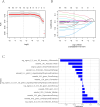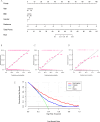CT-based whole lung radiomics nomogram for identification of PRISm from non-COPD subjects
- PMID: 39227894
- PMCID: PMC11373438
- DOI: 10.1186/s12931-024-02964-2
CT-based whole lung radiomics nomogram for identification of PRISm from non-COPD subjects
Abstract
Background: Preserved Ratio Impaired Spirometry (PRISm) is considered to be a precursor of chronic obstructive pulmonary disease. Radiomics nomogram can effectively identify the PRISm subjects from non-COPD subjects, especially when during large-scale CT lung cancer screening.
Methods: Totally 1481 participants (864, 370 and 247 in training, internal validation, and external validation cohorts, respectively) were included. Whole lung on thin-section computed tomography (CT) was segmented with a fully automated segmentation algorithm. PyRadiomics was adopted for extracting radiomics features. Clinical features were also obtained. Moreover, Spearman correlation analysis, minimum redundancy maximum relevance (mRMR) feature ranking and least absolute shrinkage and selection operator (LASSO) classifier were adopted to analyze whether radiomics features could be used to build radiomics signatures. A nomogram that incorporated clinical features and radiomics signature was constructed through multivariable logistic regression. Last, calibration, discrimination and clinical usefulness were analyzed using validation cohorts.
Results: The radiomics signature, which included 14 stable features, was related to PRISm of training and validation cohorts (p < 0.001). The radiomics nomogram incorporating independent predicting factors (radiomics signature, age, BMI, and gender) well discriminated PRISm from non-COPD subjects compared with clinical model or radiomics signature alone for training cohort (AUC 0.787 vs. 0.675 vs. 0.778), internal (AUC 0.773 vs. 0.682 vs. 0.767) and external validation cohorts (AUC 0.702 vs. 0.610 vs. 0.699). Decision curve analysis suggested that our constructed radiomics nomogram outperformed clinical model.
Conclusions: The CT-based whole lung radiomics nomogram could identify PRISm to help decision-making in clinic.
Keywords: Computed tomography; Nomogram; PRISm; Radiomics.
© 2024. The Author(s).
Conflict of interest statement
The authors declare no competing interests.
Figures





References
-
- China. https://www.stats.gov.cn/
MeSH terms
Grants and funding
- 81930049/National Natural Science Foundation of China
- 82171926/National Natural Science Foundation of China
- 2022YFC2010000/National Key Research and Development Program of China
- 2022YFC2010002/National Key Research and Development Program of China
- YXFSC2022JJSJ002/Medical Imaging Database Construction Program of National Health Commission
LinkOut - more resources
Full Text Sources
Medical

